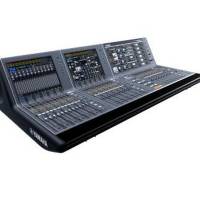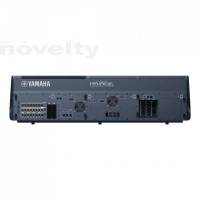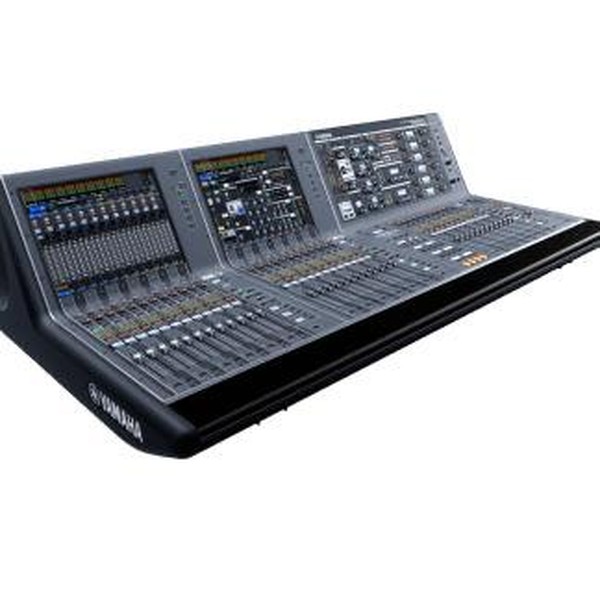SonCSD-R7 YAMAHA Console 120in/84out 38 faders PM7 RIVAGE




Quantité
ex
Liste des Projets disponibles
Description
Caractéristiques
Partager
Fiche Produit
la console de mixage PM7 (nom de code CSD-R7 pour la surface de contrôle) vient épauler la PM10 dans la série Rivage et perpétuer la lignée (bientôt quadragénaire) des consoles numériques PM du constructeur nippon.
Déclinaison de la PM10 dont elle reprend la ligne (sans le bandeau en ronce de noyer), et la grande majorité des performances et fonctionnalités, elle apporte toutefois quelques nouveautés et améliorations, qui abaissent substantiellement le coût d’acquisition et d’exploitation dans des configurations courantes.
Déclinaison de la PM10 dont elle reprend la ligne (sans le bandeau en ronce de noyer), et la grande majorité des performances et fonctionnalités, elle apporte toutefois quelques nouveautés et améliorations, qui abaissent substantiellement le coût d’acquisition et d’exploitation dans des configurations courantes.
La surface de contrôle CSD-R7 conserve l’intégralité de la présentation et de l’ergonomie de la série Rivage avec ses trois bacs de 12 faders plus deux masters, les deux écrans LCD couleur tactiles (contrôle « centralogic » avec les bacs du dessous), et le panneau de contrôle de voie (canal d’entrée ou mix) et d’assignation complet placé à droite. Ce qui change, c’est que le moteur audio DSP Rivage est maintenant incorporé dans la surface de contrôle et non en externe (relié via le réseau audio numérique optique TWINLANe) et qu’avec les nouveaux racks distants Rio3224-D2 (32 in/24 out) et Rio1608-D2 (16 in/8 out) Dante, il est possible de travailler exclusivement en réseau Dante, mais bien sûr également en TWINLANe avec le parc d’équipements existant du système Rivage.
Coté traitement (en 96 kHz), les capacités sont légèrement moindres que sur une PM10, avec le support de 120 canaux mono d’entrée (144 sur un système PM10), 60 bus de mix (au lieu de 72), 24 matrices (36), deux bus PFL (idem) et 24 groupes DCA (idem) mais tout de même conséquentes. Bien entendu, la compensation de gain est assurée entre surfaces. A noter que le firmware Rivage V2.0, placé d’entrée sur la PM7, apporte quelques possibilités supplémentaires avec le panning et le monitoring en 5.1 par exemple et la fonction « minus » permettant d’ôter une source d’un mix rapidement.
Le panneau de contrôle complet de voie (canal ou mix) rassemble tous les paramétrages et les affectations possibles. Noter le cadre grisé « SILK » qui permet d’insérer le traitement d’émulation des pré-amplis Ruppert Neve.
Les entrées analogiques en local (8 avec 8 sorties et 8 E/S AES) bénéficient des nouveaux pré-amplis hybrides (composants discrets+ intégrés) installés sur les nouveaux Rio (1608-D2 et 3224-D2) dont par exemple le contrôle de gain analogique a été revu et amélioré. Le traitement SILK Rupert Neve et l’émulation du comportement de transformateur VCM (virtual circuit modeling) apporte des caractéristiques de compression et de saturation douce très recherchées.
La PM7 incorpore par ailleurs un auto-mixeur Dan Dugan 64 canaux et offre 48 plug-ins VCM (50 sur une PM10) reprenant les effets de périphériques renommés notamment de Rupert Neve en EQ/compression mais également d’Eventide (Ultra-Harmonizer H3000 par exemple). La capacité de traitement du moteur audio permet travailler avec 192 instances de plug-ins tels que Portico 5033 ou 5043 en simultané. Avec la version V2.0 du firmware, l’émulation du Portico 5045 est également possible, ce qui sera apprécié sur les entrées micro. Au total, l’ingé son peut donc se passer facilement de traitements externes s’il le souhaite.
En face arrière, de gauche à droite, les E/S locales analogiques et numériques AES, les deux slots pour carte MY, les ports USB pour souris ou clavier, les ports Ethernet de contrôle, une sortie vidéo pour écran externe, les deux embases d’alimentation et enfin à droite les 3 slots pour cartes réseau HY avec au-dessus les E/S de synchro wordclock.
Les cartes réseau HY256-TL (TWINLANe 256 E/S 32bits/96 kHz) et HY144-D (Dante 144 E/S 32 bits/96 kHz).
Coté réseau audio, comme nous l’avons évoqué, on peut travailler en TWINLANe avec une carte HY256-TL (ou TL-SMF, fibre monomode) supportant 256 canaux en entrée et en sortie en 32 bits/96 kHz et/ou en Dante avec une carte HY144-D (144 canaux en entrée et en sortie, 32 bits/96 kHz) et bientôt en MADI (une carte est prévue sous peu) en plaçant la ou les cartes ad hoc dans un des trois slots prévus à cet effet en face arrière.
La particularité du système PM7 étant qu’on peut n’utiliser que le Dante avec les nouveaux Rio (et tous les appareils supportant Dante) et les switches Yamaha SWP1-8 et 1-16 SMF et donc aboutir à des configurations plus économiques. Deux autres slots en face arrière acceptent toutes les cartes Yamaha MY.
Les nouveaux racks Dante Rio1608-D2 et Rio3224-D2 disposent d’un écran de paramétrage OLED et de nouveaux pré-amplis hybrides.
La surface de travail CSD-R7 comme les Rio Dante intègrent une double alimentation redondante. Ces derniers accueillent maintenant un afficheur OLED qui permet le paramétrage en local (interactif).
Enfin la console peut être contrôlée en Wi-Fi d’une tablette iPAD avec Rivage PM StageMix et il est possible de préparer son show offline sur PC ou MAC avec Rivage PM editor, sans oublier le convertisseur Yamaha Console File Converter qui permet de partager des données entre différents systèmes Yamaha : Rivage PM, CL / QL, PM5, M7CL.
Environnement complet possible avec le système PM7 Rivage
Coté traitement (en 96 kHz), les capacités sont légèrement moindres que sur une PM10, avec le support de 120 canaux mono d’entrée (144 sur un système PM10), 60 bus de mix (au lieu de 72), 24 matrices (36), deux bus PFL (idem) et 24 groupes DCA (idem) mais tout de même conséquentes. Bien entendu, la compensation de gain est assurée entre surfaces. A noter que le firmware Rivage V2.0, placé d’entrée sur la PM7, apporte quelques possibilités supplémentaires avec le panning et le monitoring en 5.1 par exemple et la fonction « minus » permettant d’ôter une source d’un mix rapidement.
Le panneau de contrôle complet de voie (canal ou mix) rassemble tous les paramétrages et les affectations possibles. Noter le cadre grisé « SILK » qui permet d’insérer le traitement d’émulation des pré-amplis Ruppert Neve.
Les entrées analogiques en local (8 avec 8 sorties et 8 E/S AES) bénéficient des nouveaux pré-amplis hybrides (composants discrets+ intégrés) installés sur les nouveaux Rio (1608-D2 et 3224-D2) dont par exemple le contrôle de gain analogique a été revu et amélioré. Le traitement SILK Rupert Neve et l’émulation du comportement de transformateur VCM (virtual circuit modeling) apporte des caractéristiques de compression et de saturation douce très recherchées.
La PM7 incorpore par ailleurs un auto-mixeur Dan Dugan 64 canaux et offre 48 plug-ins VCM (50 sur une PM10) reprenant les effets de périphériques renommés notamment de Rupert Neve en EQ/compression mais également d’Eventide (Ultra-Harmonizer H3000 par exemple). La capacité de traitement du moteur audio permet travailler avec 192 instances de plug-ins tels que Portico 5033 ou 5043 en simultané. Avec la version V2.0 du firmware, l’émulation du Portico 5045 est également possible, ce qui sera apprécié sur les entrées micro. Au total, l’ingé son peut donc se passer facilement de traitements externes s’il le souhaite.
En face arrière, de gauche à droite, les E/S locales analogiques et numériques AES, les deux slots pour carte MY, les ports USB pour souris ou clavier, les ports Ethernet de contrôle, une sortie vidéo pour écran externe, les deux embases d’alimentation et enfin à droite les 3 slots pour cartes réseau HY avec au-dessus les E/S de synchro wordclock.
Les cartes réseau HY256-TL (TWINLANe 256 E/S 32bits/96 kHz) et HY144-D (Dante 144 E/S 32 bits/96 kHz).
Coté réseau audio, comme nous l’avons évoqué, on peut travailler en TWINLANe avec une carte HY256-TL (ou TL-SMF, fibre monomode) supportant 256 canaux en entrée et en sortie en 32 bits/96 kHz et/ou en Dante avec une carte HY144-D (144 canaux en entrée et en sortie, 32 bits/96 kHz) et bientôt en MADI (une carte est prévue sous peu) en plaçant la ou les cartes ad hoc dans un des trois slots prévus à cet effet en face arrière.
La particularité du système PM7 étant qu’on peut n’utiliser que le Dante avec les nouveaux Rio (et tous les appareils supportant Dante) et les switches Yamaha SWP1-8 et 1-16 SMF et donc aboutir à des configurations plus économiques. Deux autres slots en face arrière acceptent toutes les cartes Yamaha MY.
Les nouveaux racks Dante Rio1608-D2 et Rio3224-D2 disposent d’un écran de paramétrage OLED et de nouveaux pré-amplis hybrides.
La surface de travail CSD-R7 comme les Rio Dante intègrent une double alimentation redondante. Ces derniers accueillent maintenant un afficheur OLED qui permet le paramétrage en local (interactif).
Enfin la console peut être contrôlée en Wi-Fi d’une tablette iPAD avec Rivage PM StageMix et il est possible de préparer son show offline sur PC ou MAC avec Rivage PM editor, sans oublier le convertisseur Yamaha Console File Converter qui permet de partager des données entre différents systèmes Yamaha : Rivage PM, CL / QL, PM5, M7CL.
Environnement complet possible avec le système PM7 Rivage